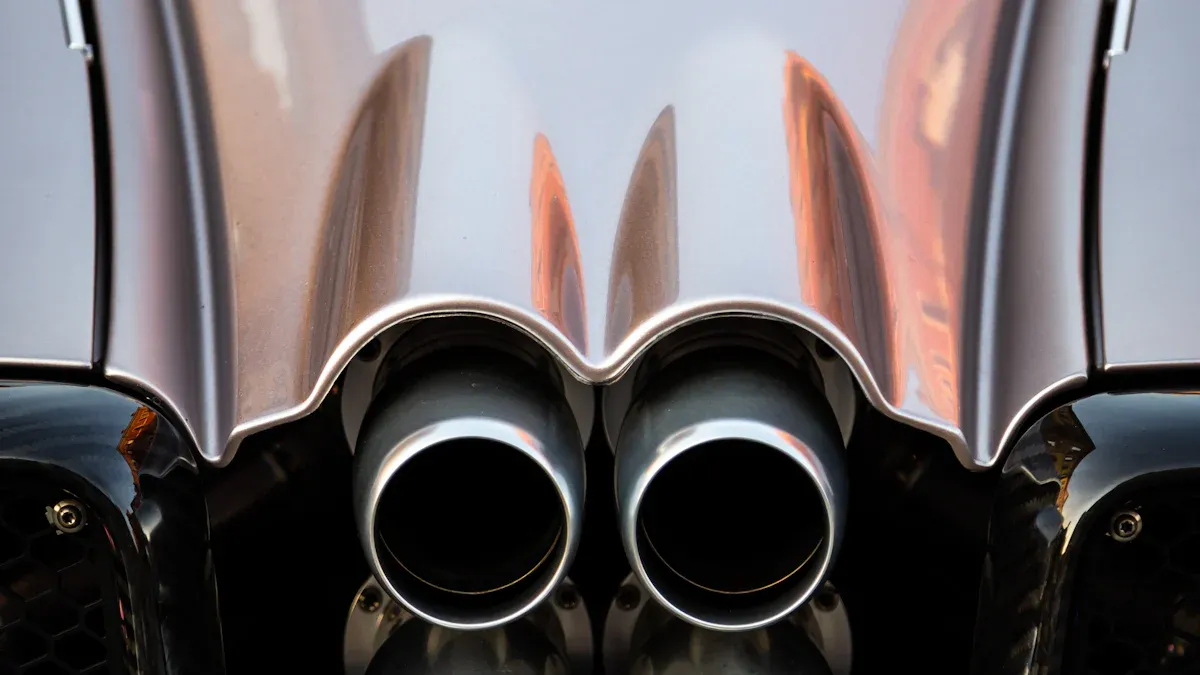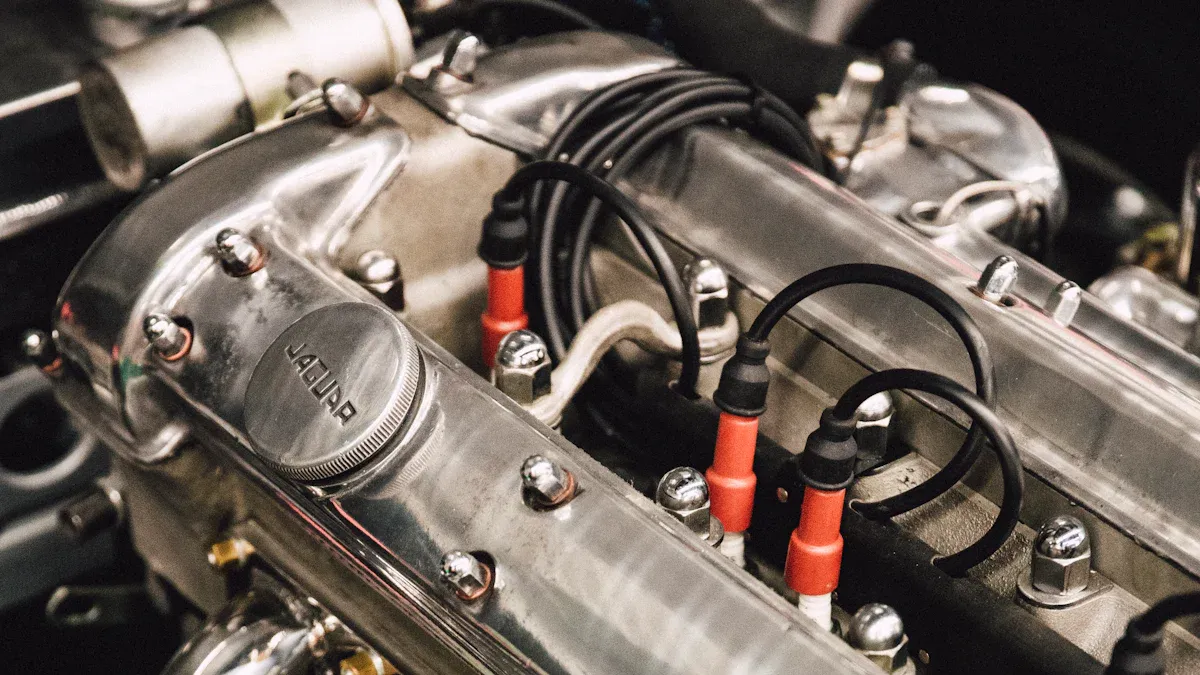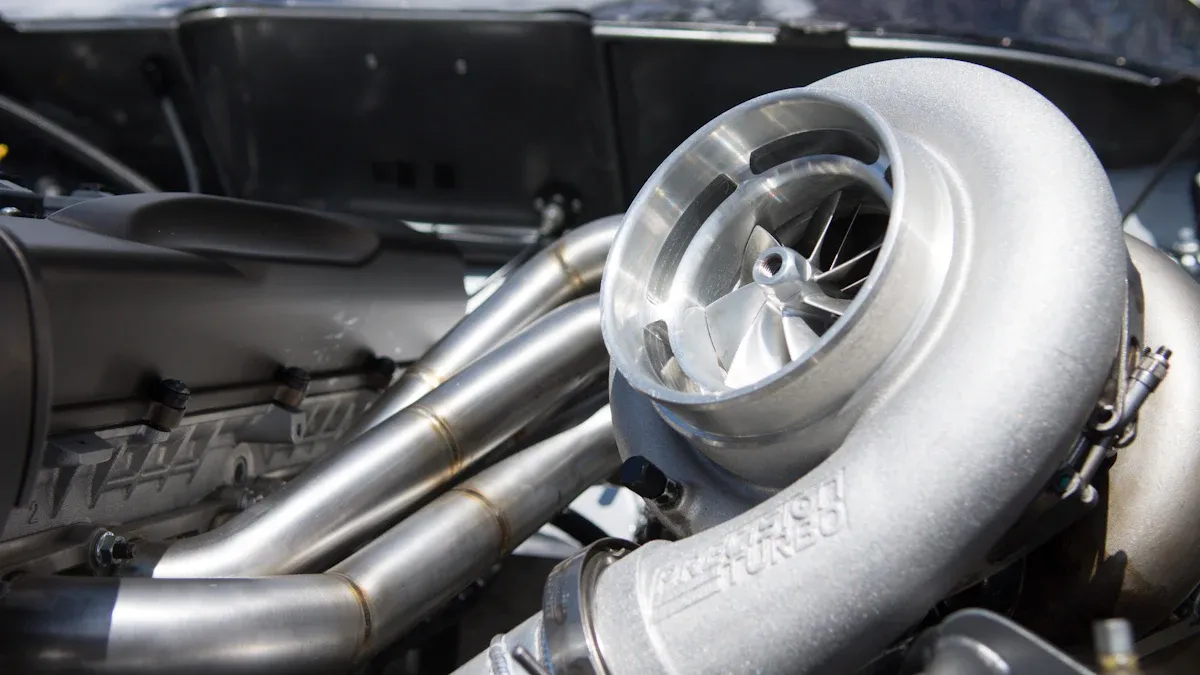
Stainless steel exhaust manifolds excel in harsh environments due to their exceptional corrosion resistance. Their robust design withstands extreme conditions, ensuring optimal performance and reliability. These manifolds integrate seamlessly into exhaust system manifold setups, offering superior durability for automotive and industrial applications. Their ability to function effectively alongside inlet and exhaust manifold converters enhances efficiency across diverse operational settings.
Why Stainless Steel is the Best Choice for Exhaust Manifolds

Corrosion Resistance and High Chromium Content
Stainless steel stands out as the ideal material for exhaust manifolds due to its exceptional corrosion resistance. The high chromium content in stainless steel plays a pivotal role in this property. Chromium reacts with oxygen to form a protective chrome-oxide layer on the surface. This layer acts as a barrier against rust and other forms of corrosion, ensuring the manifold’s integrity even in harsh environments.
The self-healing nature of the chrome-oxide layer further enhances its durability. When the surface gets scratched or damaged, the layer regenerates, maintaining protection. Low-carbon grades of stainless steel, such as 321 SS, are particularly effective for exhaust manifolds. These alloys include titanium, which stabilizes carbides and prevents issues like carbide precipitation. This feature is crucial for maintaining corrosion resistance at elevated temperatures, where standard materials might fail.
Tip: Choosing stainless steel with high chromium content ensures long-term performance and reliability for exhaust manifolds exposed to extreme conditions.
Thermal Stability and High-Temperature Performance
Exhaust manifolds operate under intense heat, often reaching temperatures between 900°F and 1400°F (482°C to 760°C). Stainless steel excels in such environments due to its remarkable thermal stability. Unlike other materials, stainless steel resists deformation and maintains its structural integrity under prolonged exposure to high temperatures.
The high chromium content in stainless steel prevents carbide precipitation, a phenomenon that occurs when chromium is depleted from the alloy’s grains. This depletion weakens the protective chrome-oxide layer, making the material vulnerable to corrosion. Stainless steel alloys designed for high-temperature applications, such as 321 SS, mitigate this risk, ensuring consistent performance.
Note: Thermal stability is essential for exhaust manifolds in vehicles and machinery that operate in demanding conditions. Stainless steel ensures reliability and safety in these applications.
Longevity and Cost Efficiency in Harsh Conditions
Stainless steel exhaust manifolds offer unmatched longevity, making them a cost-effective choice for industries. Their resistance to corrosion and thermal stress reduces the need for frequent replacements, saving both time and money. The durability of stainless steel ensures that exhaust manifolds can withstand exposure to salt, moisture, and chemicals without compromising performance.
In addition to their physical resilience, stainless steel manifolds contribute to operational efficiency. Their ability to maintain functionality in extreme environments minimizes downtime and repair costs. Industries such as automotive, marine, and industrial equipment benefit significantly from the long-term reliability of stainless steel exhaust manifolds.
Callout: Investing in stainless steel exhaust manifolds ensures durability and cost savings, making them a smart choice for harsh environments.
Key Features and Benefits of Stainless Steel Exhaust Manifolds
Resistance to Salt, Moisture, and Chemicals
Stainless steel exhaust manifolds excel in environments where exposure to salt, moisture, and chemicals is unavoidable. These conditions often lead to corrosion in conventional materials, compromising performance and durability. Stainless steel’s inherent resistance to these elements ensures long-term reliability. The protective chrome-oxide layer formed by its high chromium content acts as a shield, preventing rust and chemical reactions that degrade the material.
Industries such as marine and offshore rely heavily on this feature. Saltwater environments are particularly harsh, but stainless steel manifolds maintain their structural integrity and functionality. This resistance also benefits vehicles operating in regions with heavy snowfall, where road salt accelerates corrosion.
Tip: Regular cleaning enhances the manifold’s resistance to salt and chemicals, ensuring optimal performance in challenging conditions.
Lightweight Yet Structurally Strong Design
Stainless steel exhaust manifolds combine lightweight construction with exceptional strength. This balance is achieved through advanced engineering techniques, including the finite element method (FEM). FEM simulations optimize the manifold’s shape and material properties, ensuring structural integrity without adding unnecessary weight.
- Key engineering insights:
- FEM models simulate various designs under load and heat conditions, ensuring durability.
- Numerical analysis refines the manifold’s shape for improved performance.
- Optimized designs maintain strength while reducing material usage.
This lightweight yet robust design enhances fuel efficiency and reduces strain on the exhaust system. Vehicles benefit from improved handling and reduced wear on connected components. The structural strength ensures the manifold withstands thermal stress and mechanical loads, even in demanding applications.
Enhanced Durability for Long-Term Use
Durability defines stainless steel exhaust manifolds. Their ability to resist corrosion, thermal stress, and mechanical wear ensures long-term functionality. Unlike traditional materials, stainless steel maintains its performance over extended periods, reducing the need for replacements.
Industries prioritize durability to minimize downtime and maintenance costs. Stainless steel manifolds deliver consistent performance in harsh environments, including high-temperature industrial settings and corrosive marine conditions. Their longevity makes them a cost-effective solution for applications requiring reliability and resilience.
Callout: Stainless steel exhaust manifolds offer unmatched durability, making them a preferred choice for industries seeking long-term solutions.
Applications of Stainless Steel Exhaust Manifolds

Automotive Industry: Cars, Trucks, and Heavy-Duty Vehicles
Stainless steel exhaust manifolds play a critical role in the automotive industry. Their corrosion resistance and thermal stability make them ideal for cars, trucks, and heavy-duty vehicles. These vehicles often operate in extreme conditions, such as high temperatures and exposure to road salt. Stainless steel ensures the exhaust manifold remains functional and durable under these challenges. Additionally, its lightweight design reduces the overall weight of the vehicle, improving fuel efficiency and performance. Manufacturers rely on stainless steel to meet the demands of modern automotive engineering, ensuring reliability and longevity.
Marine and Offshore Environments
Marine and offshore environments present unique challenges, including constant exposure to saltwater and humidity. Stainless steel exhaust manifolds excel in these conditions due to their exceptional resistance to corrosion. Boats, ships, and offshore platforms benefit from their ability to withstand the harsh effects of salt and moisture. This durability reduces maintenance requirements and extends the lifespan of the equipment. Stainless steel’s structural strength also ensures it can handle the mechanical stresses of marine operations, making it a preferred choice for these demanding applications.
Industrial Equipment and Machinery
Industrial equipment and machinery often operate in environments with high temperatures, chemical exposure, and mechanical stress. Stainless steel exhaust manifolds provide the durability and reliability needed for such conditions. Their resistance to corrosion and thermal stress ensures consistent performance, even in the most challenging industrial settings. Industries such as manufacturing, power generation, and construction rely on stainless steel manifolds to maintain operational efficiency. The material’s long lifespan and low maintenance requirements make it a cost-effective solution for industrial applications.
Maintenance Tips for Stainless Steel Exhaust Manifolds
Regular Cleaning to Prevent Corrosion Build-Up
Routine cleaning is essential to maintain the performance and longevity of stainless steel exhaust manifolds. Dust, dirt, and chemical residues can accumulate on the surface over time, potentially compromising the protective chrome-oxide layer. Cleaning removes these contaminants and prevents corrosion build-up.
To clean effectively:
- Use a soft cloth or sponge with mild soap and water.
- Avoid abrasive materials that may scratch the surface.
- Rinse thoroughly to remove any cleaning agents.
Tip: For stubborn stains, apply a stainless steel cleaner specifically designed for automotive parts. This ensures the manifold retains its polished appearance and protective properties.
Inspection for Damage in Harsh Environments
Regular inspections help identify potential issues before they escalate. Harsh environments, such as those with high humidity or salt exposure, can cause stress or minor damage to the manifold. Early detection ensures timely repairs and prevents costly replacements.
Key areas to inspect include:
- Welded joints for cracks or signs of wear.
- Surface discoloration, which may indicate overheating.
- Mounting points for loose bolts or misalignment.
Note: Schedule inspections during routine vehicle maintenance to ensure consistent performance.
Proper Installation to Avoid Stress and Cracks
Correct installation plays a vital role in the manifold’s durability. Improper mounting can lead to stress points, which may cause cracks or deformation under high temperatures. Following manufacturer guidelines ensures a secure and stress-free fit.
Installation best practices:
- Use the recommended torque settings for bolts.
- Ensure proper alignment with the exhaust system.
- Avoid over-tightening, which can strain the material.
Callout: Professional installation services guarantee optimal performance and extend the lifespan of stainless steel exhaust manifolds.
Stainless steel exhaust manifolds offer unmatched corrosion resistance and durability, making them ideal for harsh environments. Their versatility spans automotive, marine, and industrial applications. Ningbo Werkwell’s expertise in manufacturing ensures high-quality products tailored to industry needs. Their commitment to precision and innovation guarantees reliable solutions for diverse operational demands.
FAQ
What makes stainless steel exhaust manifolds ideal for harsh environments?
Stainless steel resists corrosion, handles high temperatures, and maintains structural integrity. Its durability ensures reliable performance in challenging conditions.
How does Ningbo Werkwell ensure product quality?
Werkwell employs advanced testing facilities, experienced QC teams, and precise engineering. Their OEM/ODM services meet diverse customer requirements.
Can stainless steel exhaust manifolds be used in marine applications?
Yes, stainless steel withstands saltwater exposure and humidity. Its corrosion resistance makes it suitable for boats, ships, and offshore platforms.
Post time: Apr-29-2025



